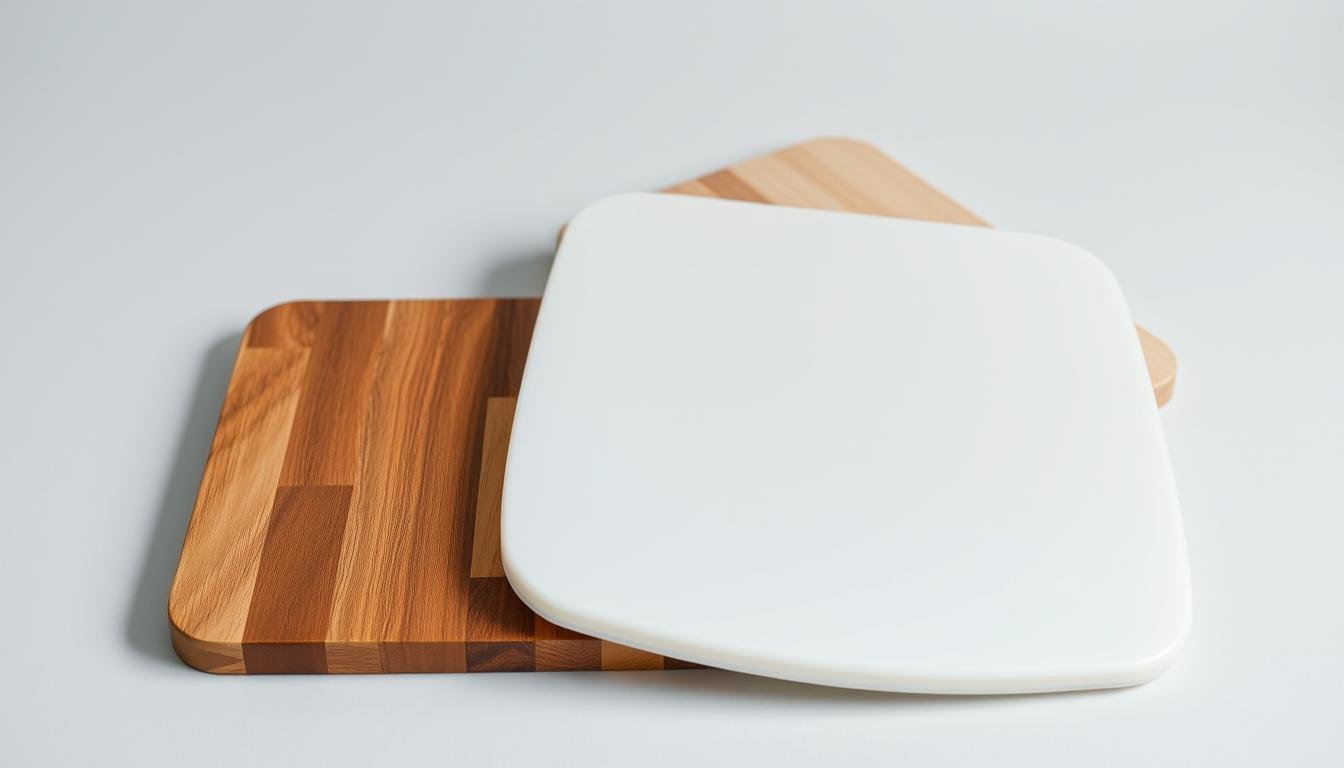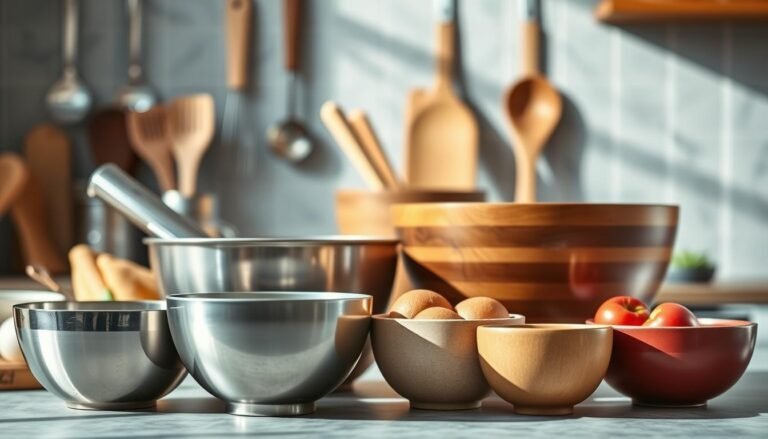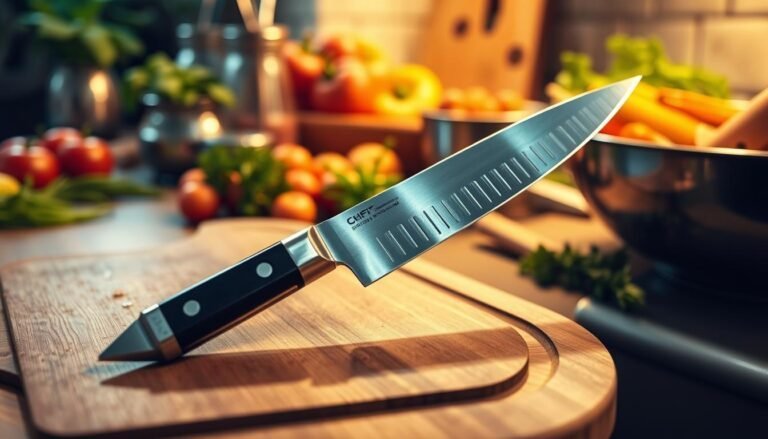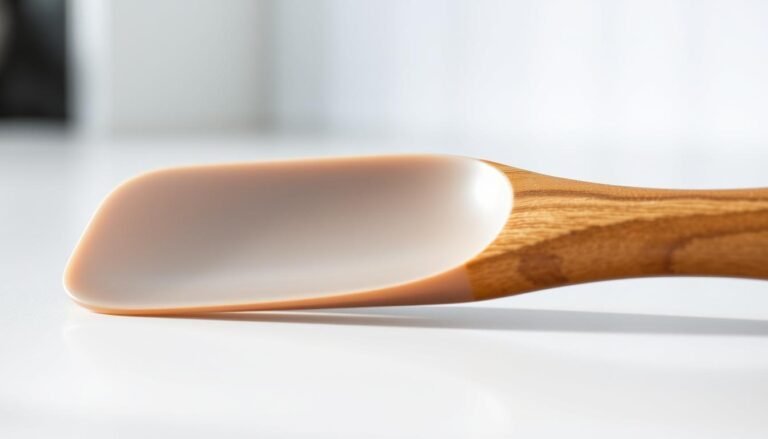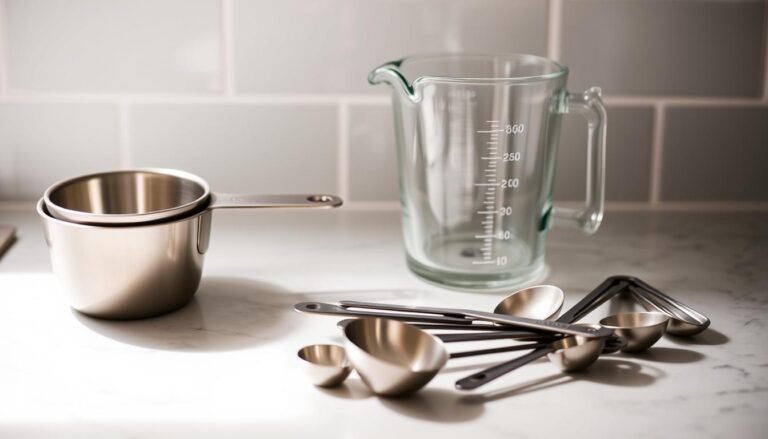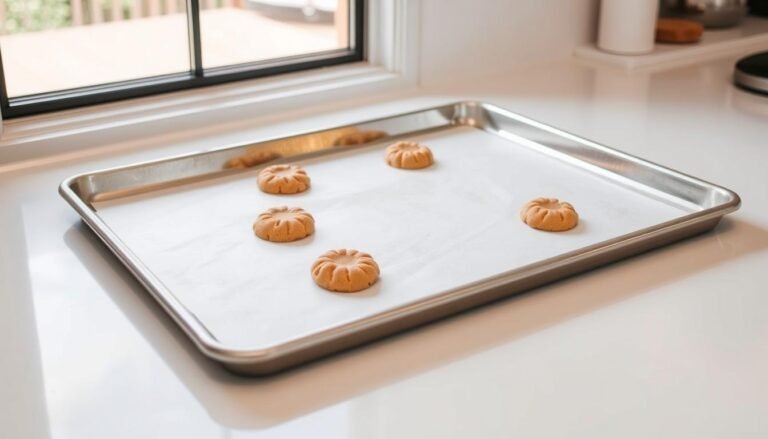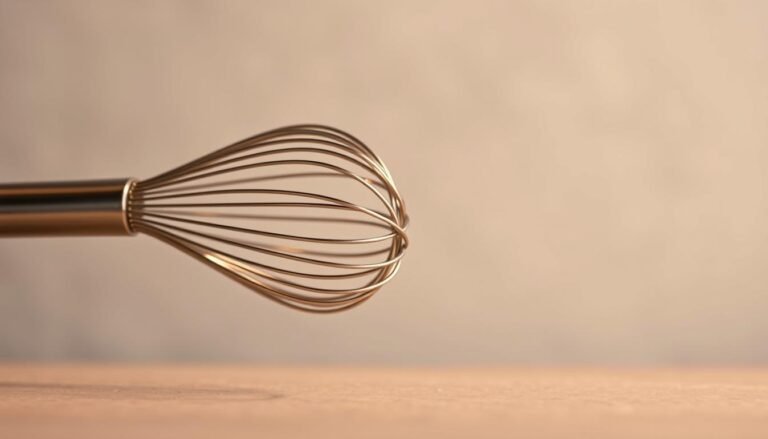Disclosure: This Post Contains Affiliate Links; We earn a commission on purchases.
A cutting board is a key tool in the kitchen. The debate between wood and plastic cutting boards is ongoing. Each has its own benefits and drawbacks.
A wooden cutting board is loved for its beauty and how it treats knives. Plastic cutting boards are easy to clean and don’t scratch easily. Knowing the good and bad of each is important.
Key Takeaways
- The choice between wood and plastic cutting boards depends on personal preference and kitchen needs.
- Durability and maintenance are key factors in selecting the best cutting board.
- Hygiene is a critical consideration, with some materials being more prone to harboring bacteria.
- The best cutting board balances functionality with ease of care.
- Understanding the pros and cons of each material helps in making an informed choice.
The Essential Role of Cutting Boards in Your Kitchen
Cutting boards are key in the kitchen. They affect how well food is prepared and how long knives last. A kitchen cutting board is more than a surface. It’s a vital tool that makes cooking safer and more efficient.
Cutting boards are used for many tasks. They help with chopping veggies and slicing meat. This makes them a must-have for every meal.
Why Quality Matters for Food Preparation
The quality of a cutting board is very important. A good plastic cutting board or wooden one keeps food safe. It stops germs from spreading and keeps the surface clean.
Choosing a durable and easy-to-clean cutting board is key. It helps keep your kitchen clean and safe.
How Cutting Boards Affect Knife Longevity
The type of cutting board used can also affect knives. A hard board can dull knives fast. But a softer material helps keep blades sharp.
A dishwasher safe cutting board made from the right material is great. It’s easy to clean and good for knives, making it a smart choice for daily use.
Wooden Cutting Boards: Traditional Excellence
Many home cooks and chefs love wooden cutting boards for their classic charm. They are known for lasting long and looking great. This makes them a key part of many kitchens.
Types of Wood Used for Cutting Boards
Wood types vary, with maple and walnut being favorites. The wood you pick can change how long the board lasts and how easy it is to care for.
Maple, Oak, and Walnut Comparisons
- Maple: Maple is loved for its light color and smooth grain. It’s tough and won’t scratch easily.
- Oak: Oak is denser than maple and has a unique grain. It’s strong and lasts a long time.
- Walnut: Walnut boards are dark and add class to any kitchen. They’re also very durable.
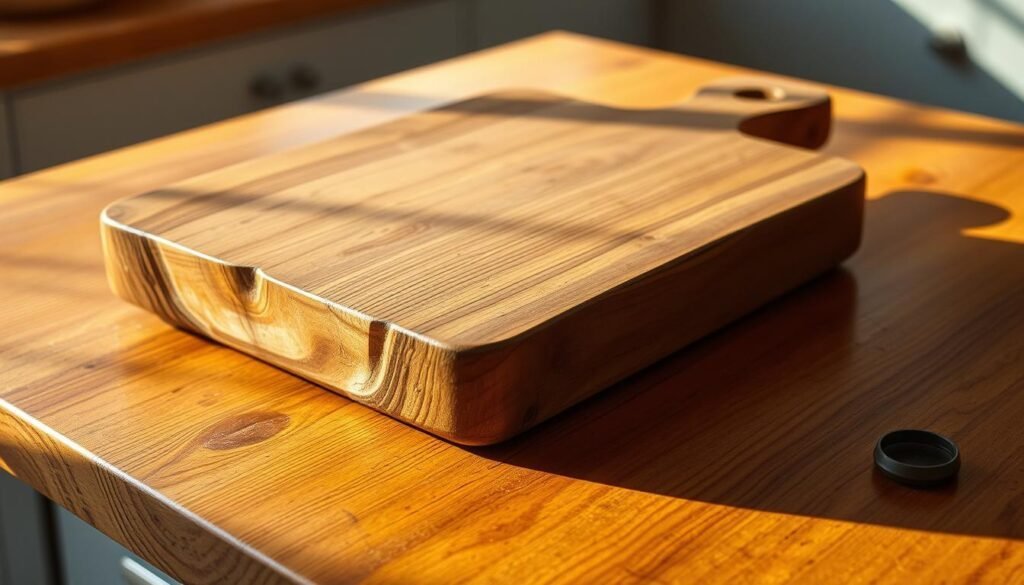
Benefits of Hardwood Options
Hardwood boards, like those from maple, oak, and walnut, have many perks. They naturally fight off bacteria and last a long time. This makes them a clean choice for cooking.
Bamboo Cutting Boards: The Sustainable Alternative
Bamboo cutting boards are a green option compared to hardwoods. Bamboo grows fast and needs less water and pesticides. It’s a smart pick for those who care about the planet.
Plastic Cutting Board Options and Benefits
Plastic cutting boards are popular in kitchens. They are easy to clean and come in many colors. They are great for both home cooks and professional chefs.
Types of Plastic Materials Used
Plastic cutting boards are made from different plastics. The most common are polyethylene and polypropylene.
Polyethylene vs. Polypropylene
Polyethylene is tough and can handle a lot of use. Polypropylene is flexible and less likely to get scratches or cracks. Knowing the difference helps you pick the right board.
Advantages of Dishwasher Safe Cutting Boards
Many plastic cutting boards are dishwasher safe. This makes cleaning simple and saves time. They can also be sanitized at high temperatures, keeping food safe.
Color-Coding for Food Safety
Plastic cutting boards come in various colors. These colors help with color-coding to keep foods separate. This is good for both home and commercial kitchens. It helps prevent cross-contamination.
The Great Debate: Wood vs. Plastic Cutting Board Comparison
The debate between wooden and plastic cutting boards has been ongoing. Each side has its own arguments about durability, hygiene, and environmental impact. The choice between these two materials depends on several key factors.
Durability and Longevity Comparison
Wooden cutting boards, made from hardwoods, are very durable. They can last for many years with proper care. Plastic cutting boards are also durable but may show wear faster than wood.
According to Ruvati, both types can last a long time with the right care.
Hygiene and Food Safety Considerations
Hygiene is key when it comes to cutting boards. Studies show mixed results on whether wood or plastic is better at resisting bacteria.
Bacterial Resistance Studies
Some studies say wooden cutting boards might have antibacterial properties. This could lower the risk of bacterial contamination. But other studies show that both wood and plastic can harbor bacteria if not cleaned well.
Cross-Contamination Prevention
Cross-contamination is a big worry in kitchens. It’s best to use separate cutting boards for different foods. This rule applies to both wood and plastic cutting boards.
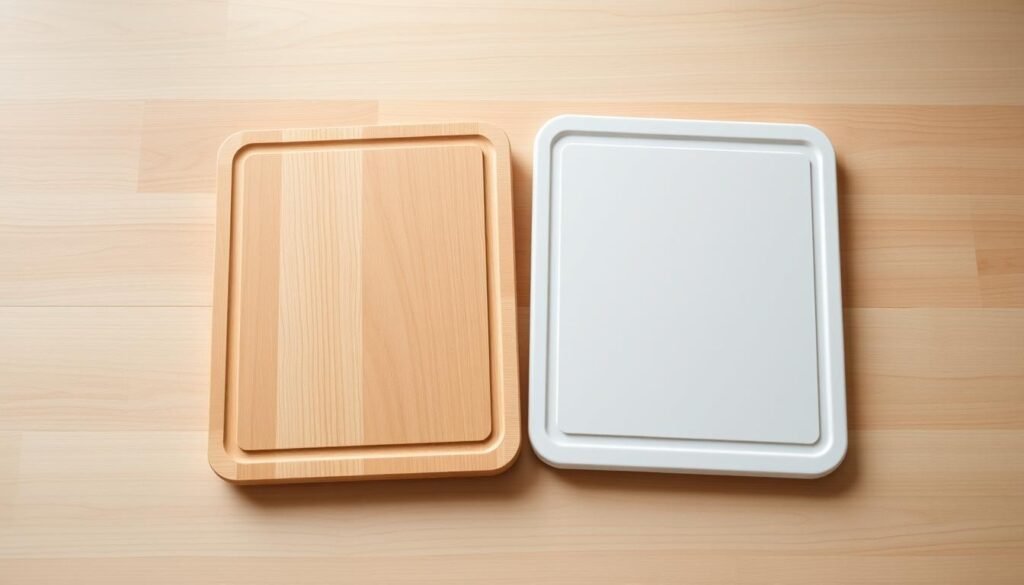
Environmental Impact Assessment
The environmental impact of wooden versus plastic cutting boards is important. Wooden cutting boards are seen as more eco-friendly because they come from natural, renewable resources. Plastic cutting boards, made from non-renewable resources, can contribute to plastic waste.
But, wooden cutting boards can be used for many years. This can make up for their initial environmental impact.
Alternative Cutting Board Materials
The kitchen is seeing new cutting board materials. Each has its own benefits.
Wood and plastic are common, but new options are popular too. They offer unique qualities.
Glass and Marble Cutting Surfaces
Glass and marble cutting boards look sleek and modern. They’re also easy to clean. But, they can be tough on knives and might break if hit hard. Marble is cold, making it great for handling delicate foods like meat and fish.
Composite and Rubber Cutting Boards
Composite boards are tough and won’t scratch easily. Rubber boards are kind to knives. They’re soft and easy on your hands.
Organic Cutting Board Options
Organic cutting boards are good for the planet. They’re made from natural, renewable stuff. These boards add a natural beauty to your kitchen.
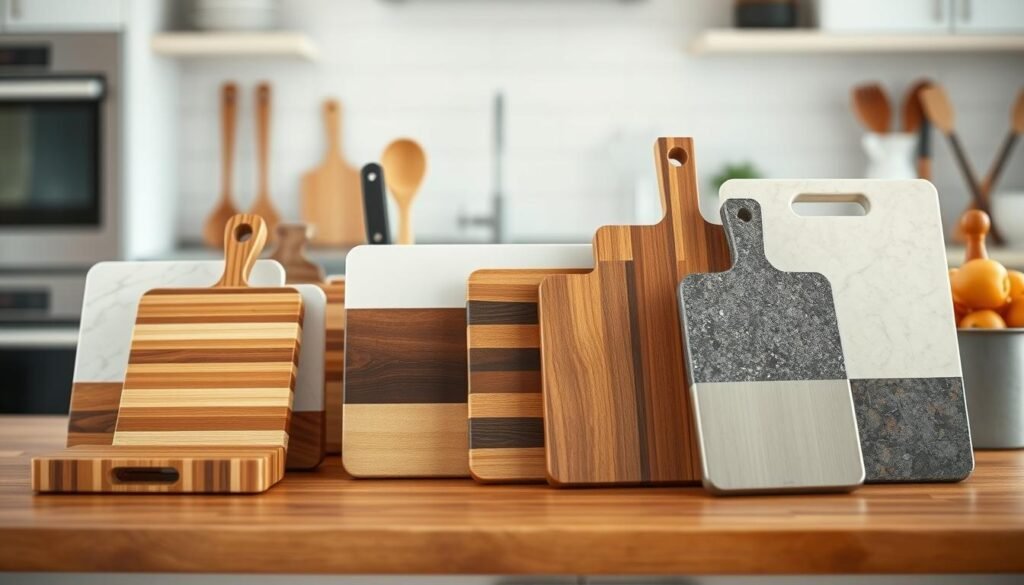
How to Choose the Best Cutting Board for Your Needs
Knowing what you cook is key to picking the right kitchen cutting board. Think about the food you make, how you cook, and what you like in a cutting board. Size, thickness, and material matter a lot.
Matching Cutting Boards to Cooking Styles
Each cooking style needs a specific cutting board. For example, meat lovers need a board that’s tough and easy to clean.
Meat Preparation Considerations
For cutting meat, choose a board made from hardwood or top-notch plastic. These materials are strong and easy to clean.
Vegetable and Fruit Preparation
For veggies and fruits, pick a board that’s soft on knives and easy to clean. Bamboo or certain woods are great choices.
Size and Thickness Considerations
The size and thickness of your cutting board matter too. A big board gives you room to chop, and a thick one stays stable.
- A standard size is around 12×18 inches, big enough but not too big.
- Choose a thickness of 1-1.5 inches for stability.
Personalized Cutting Boards: Function and Style
A personalized cutting board adds style to your kitchen. You can get it engraved or with custom designs. It makes your kitchen stand out.
When picking a best cutting board, think about its use and look. A personalized board is a thoughtful gift or a special treat for yourself.
Proper Care and Maintenance of Kitchen Cutting Boards
Taking care of your kitchen cutting board is key for its life and safety. Each material needs its own care to stay good and clean.
Cleaning Methods for Different Materials
Wooden cutting boards need a gentle wash with mild soap. Dry them right away. Plastic cutting boards might go in the dishwasher, but check the label. Delicate materials should be hand washed carefully.
Sanitizing Techniques for Food Safety
Keeping your cutting board clean is a must for food safety. Use a bleach and water mix for both wood and plastic. White vinegar is a natural way to kill bacteria.
Extending the Life of Your Cutting Board
Keeping your cutting board in good shape needs regular care. Wooden boards should be oiled to avoid cracks.
Oiling Wood Boards
Use food-safe oil, like mineral oil, to keep your wooden cutting board in top shape. For more tips, visit Serious Eats.
Addressing Cuts and Grooves
Deep cuts and grooves can be breeding grounds for bacteria. Sanding can fix these issues on wooden cutting boards. If your plastic board has deep cuts, it might be time to replace it.
Conclusion: Making the Right Choice for Your Kitchen
Choosing the best cutting board for your kitchen is important. You need to think about durability, hygiene, and how it affects the environment. Whether you like wooden or plastic cutting boards, knowing their pros and cons is key.
The perfect cutting board matches your cooking style and what you like. For example, if you care about the planet, a bamboo cutting board is great. But, if you want something you can wash in the dishwasher, plastic might be better.
Getting the right cutting board makes cooking better and keeps your knives sharp. By looking at your options and what you need, you can find the perfect cutting board for your kitchen.
FAQ
What is the best material for a cutting board?
Are wooden cutting boards more hygienic than plastic ones?
Can I put my cutting board in the dishwasher?
How do I maintain my wooden cutting board?
What are the benefits of a bamboo cutting board?
Can I use a plastic cutting board for chopping meat and vegetables?
How often should I replace my cutting board?
Are there any alternative cutting board materials beside wood and plastic?
What size cutting board is ideal for my kitchen?
Can a cutting board be personalized?

From beginner-friendly tips to no-fuss dessert ideas, Ryan is all about helping people enjoy baking and treat-making without the stress. Whether you’re whipping up something for a party or just craving something sweet, Ryan’s practical approach makes it easy to create desserts that taste great and don’t take all day.
Subscribe to Our Newsletter

